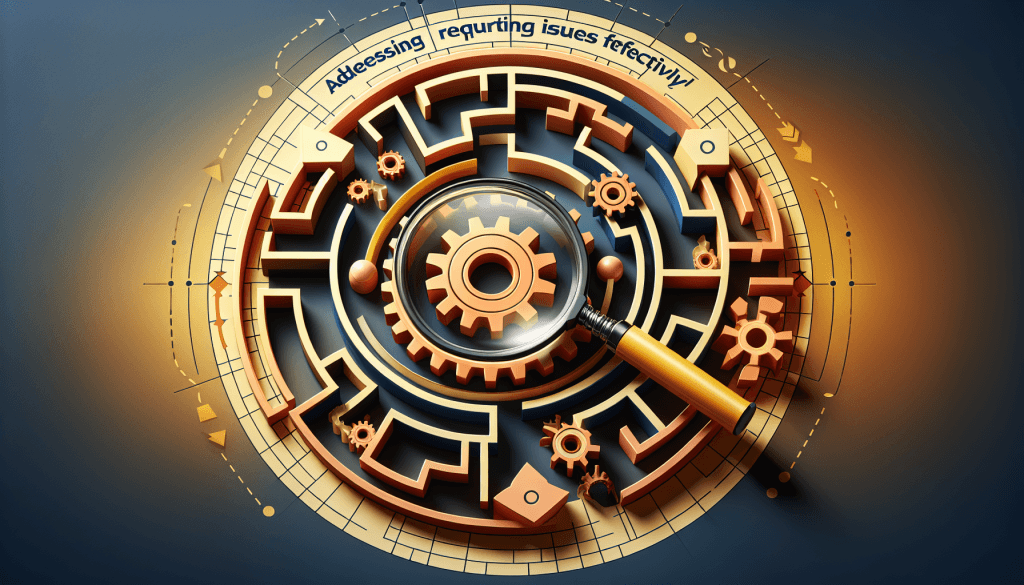Addressing recurring issues effectively is like fixing a leaky faucet—if you don’t tackle the root cause, the drip-drip-drip will drive you mad. Whether it’s in personal relationships, customer service, or workplace operations, unresolved problems can snowball into bigger headaches. This guide will walk you through practical steps to identify, address, and prevent recurring issues, ensuring smoother sailing in the future.
Key Takeaways
- Recurring issues are repetitive problems that can disrupt efficiency and satisfaction if left unaddressed.
- Identifying the root causes is crucial to solving these problems permanently.
- Leveraging tools like AI and predictive analytics can streamline the resolution process.
- Clear communication and regular updates foster trust and engagement during implementation.
- Continuous monitoring and training ensure long-term success.
Understanding Recurring Issues
Definition and Examples of Recurring Issues
Recurring issues are problems that keep popping up like weeds in a garden. They can range from minor inconveniences, like a glitchy app feature, to major disruptions, such as repeated miscommunication in a team.
For instance, a customer service department might face the same complaint about delayed deliveries week after week. Or, in personal relationships, couples might argue over the same unresolved topic repeatedly.
Importance of Addressing Recurring Issues Effectively
Ignoring recurring problems is like sweeping dirt under the rug—it might look clean for a while, but the mess is still there. Addressing these issues head-on improves efficiency, saves time, and enhances satisfaction for everyone involved.
In businesses, resolving recurring customer complaints can boost loyalty and reputation. On a personal level, tackling recurring conflicts can strengthen relationships and foster mutual understanding.
Consequences of Neglecting Recurring Problems
Neglecting recurring issues can lead to frustration, wasted resources, and even burnout. Imagine a workplace where employees constantly face the same technical glitches. Over time, morale dips, productivity plummets, and turnover increases.
In relationships, unresolved conflicts can erode trust and create emotional distance. As one therapist explains, recurring fights often stem from deeper issues that need addressing to break the cycle (source).

Identifying the Root Causes
Analyzing Common Patterns in Recurring Issues
Reviewing Support Requests for Trends
Start by gathering data. For businesses, this could mean analyzing customer complaints or support tickets. Look for patterns—are customers frequently reporting the same issue?
Identifying Underlying Causes
Once patterns emerge, dig deeper. Is the problem due to a lack of training, outdated systems, or unclear processes? Identifying the root cause is like peeling an onion—layer by layer, you get closer to the core.
Leveraging AI Tools for Root Cause Analysis
Benefits of AI in Identifying Patterns
AI tools can sift through mountains of data faster than any human. They can identify trends, flag anomalies, and even predict potential issues before they arise.
Tools and Techniques for Deeper Insights
From chatbots to predictive analytics, AI offers a treasure trove of tools to uncover hidden causes. For example, AI-driven automation can help businesses address recurring customer support issues efficiently (source).

Developing Effective Solutions
Offering Proactive Solutions and Alternatives
Demonstrating Problem-Solving to Enhance Satisfaction
Proactive solutions show that you’re not just putting out fires—you’re preventing them. For instance, if customers frequently complain about late deliveries, offering real-time tracking updates can ease their concerns.
Customizing Solutions for Specific Recurring Issues
One size rarely fits all. Tailor your approach to the specific problem. For example, if a team struggles with communication, implementing regular check-ins or collaborative tools like Slack can help.
Designing AI-Driven Solutions
Automating Responses to Common Queries
AI can handle repetitive tasks like answering FAQs, freeing up human resources for more complex issues.
Streamlining Processes with AI Tools
AI can also optimize workflows, reducing the chances of errors and delays. This not only resolves current issues but also prevents future ones.

Implementing and Communicating the Resolution Plan
Setting Clear Expectations
Ensuring All Parties Understand the Process
Transparency is key. Clearly outline the steps you’re taking to resolve the issue and what stakeholders can expect.
Establishing Realistic Timelines
Don’t promise the moon if you can’t deliver it. Set achievable deadlines and stick to them.
Providing Regular Updates
Keeping Stakeholders Informed
Regular updates build trust and show that progress is being made.
Maintaining Engagement Throughout the Process
Engage stakeholders by seeking their feedback and involving them in the solution. This fosters a sense of ownership and collaboration.

Monitoring and Evaluating Progress
Using Key Performance Indicators to Measure Effectiveness
Tracking the Impact of Implemented Solutions
Use metrics to evaluate whether the solution is working. For example, has the number of customer complaints decreased?
Adjusting Strategies Based on Results
If the solution isn’t effective, tweak it. Flexibility is crucial for long-term success.
Implementing Predictive Analytics
Anticipating Potential Recurring Issues
Predictive analytics can help you spot potential problems before they escalate.
Preventing Escalation Through Proactive Measures
By addressing issues early, you can prevent them from becoming recurring headaches.

Training and Support
Educating Staff on New Tools and Processes
Maximizing the Benefits of AI-Driven Solutions
Training ensures that employees can effectively use new tools and processes.
Ensuring Consistent Application of Strategies
Consistency is key to preventing recurring issues. Regular training sessions can help maintain standards.
Training Customers on Support Features
Enhancing User Experience
Educating customers on how to use support features can reduce frustration and improve satisfaction.
Encouraging Self-Service for Common Issues
Self-service options, like FAQs or chatbots, empower customers to resolve minor issues on their own.
Overcoming Challenges in Implementation
Managing Internal Expectations
Addressing Concerns About Automation
Some employees may fear that automation will replace their jobs. Reassure them that AI is a tool to assist, not replace, them.
Building Trust in New Processes
Trust takes time. Demonstrate the benefits of new processes through small wins.
Enhancing Customer Experiences
Balancing Automation with Personalized Support
Automation is great, but it shouldn’t replace the human touch. Strive for a balance that meets customer needs.
Ensuring Smooth Transitions During Implementation
Change can be jarring. Provide clear instructions and support to ease the transition.

Addressing recurring issues effectively requires a mix of analysis, creativity, and persistence. Whether you’re dealing with workplace inefficiencies or personal conflicts, the key is to dig deep, communicate clearly, and adapt as needed.
For more tips on building resilience and staying motivated during challenges, check out this guide. Or, if stress is a recurring issue in your life, explore techniques for managing chronic stress.
By addressing recurring issues head-on, you can create a smoother, more satisfying experience for everyone involved. After all, life’s too short to keep tripping over the same hurdles!
FAQ: Mastering the Art of Addressing Recurring Issues Effectively
What does it mean to address recurring issues effectively?
Addressing recurring issues effectively means identifying the root cause of problems that happen repeatedly and implementing sustainable solutions to prevent them from reoccurring. It involves a systematic approach rather than temporary fixes to ensure long-term success and efficiency.
Why is it important to address recurring issues instead of ignoring them?
Ignoring recurring issues can lead to wasted time, resources, and frustration. Over time, unresolved problems can escalate, affecting productivity, morale, and even customer satisfaction. Addressing them ensures smoother operations and a healthier work environment.
How can I identify the root cause of a recurring issue?
To identify the root cause, use techniques like the ‘5 Whys’ method, root cause analysis, or fishbone diagrams. These approaches help you dig deeper into the problem by asking why it occurs repeatedly, ultimately uncovering the underlying issue.
What are some common tools or methods for solving recurring problems?
Common tools include brainstorming sessions, process mapping, and data analysis. Methods like Lean Six Sigma, Agile problem-solving frameworks, and collaborative team discussions can also be highly effective in addressing recurring issues.
How can I involve my team in solving recurring issues?
Encourage open communication and collaboration by creating a safe space for team members to share their insights and ideas. Assign roles, hold regular problem-solving meetings, and recognize contributions to foster a sense of ownership and accountability.
What role does documentation play in addressing recurring issues?
Documentation is crucial as it helps track the history of the issue, the steps taken to resolve it, and the outcomes. This record can serve as a reference for future problems and ensures consistency in handling similar situations.
How can I prevent recurring issues from happening again?
Prevention involves implementing long-term solutions, monitoring the situation, and continuously improving processes. Regularly review workflows, provide training, and establish clear communication channels to minimize the chances of recurrence.
What are the benefits of effectively addressing recurring issues?
The benefits include increased efficiency, reduced costs, improved team morale, and enhanced customer satisfaction. Solving recurring issues also frees up time and resources, allowing you to focus on growth and innovation.
How can I measure the success of my efforts in solving recurring issues?
Success can be measured by tracking key performance indicators (KPIs) such as reduced downtime, fewer complaints, or improved productivity. Regular feedback from your team and stakeholders can also help gauge the effectiveness of your solutions.
What should I do if a recurring issue persists despite my efforts?
If a problem persists, reassess your approach and consider seeking external expertise or consulting with specialists. Sometimes, a fresh perspective or additional resources are needed to uncover hidden factors contributing to the issue.



